
ISSN: 3005-8198 (online) / 3005-818X (print)
Volume 1, Issue 1, pp: 18-29
![]()
Bio-Concrete and Beyond:
Advancements in Self-Healing Techniques for Durable Infrastructure
Hussein Zeaiter1,*, Ali Jahami2, Jamal Khatib1,3
1 Faculty of Engineering, Beirut Arab University, Beirut P.O. Box 11-5020, Lebanon.
2 School of Engineering, Lebanese American University, Byblos P.O. Box 13-5053, Lebanon.
3 Faculty of Engineering, University of Wolverhampton, Wolverhampton WV1 1LY, UK
E-mail: haz189@student.bau.edu.lb 1,*, ali.jahami@lau.edu.lb 2, j.khatib@bau.edu.lb 1,3
* Correspondence Author
Received: 13 July 2023 | Revised: 5 August 2023 | Accepted: 10 August 2023 | Published: 16 August 2023
Concrete is widely used in construction due to its durability and strength. However, structures made of concrete may weaken over time due to a variety of reasons, such as cracks, chemical attack, and environmental factors. This necessitates the development of new techniques to improve the lifespan and sustainability of concrete structures. Bio-concrete and self-healing techniques have emerged as viable approaches to address the challenges of concrete degradation. This literature review aims to provide a comprehensive overview of the advancements made in bio-concrete and self-healing technologies for concrete. The review begins by discussing the fundamental principles of bio-concrete, which is defined as the incorporation of bacteria or other microorganisms into the concrete matrix. These bacteria are capable of producing calcite precipitation, thereby sealing cracks and enhancing the concrete’s self-healing properties. Moreover, the review explores the mechanical and chemical characterization techniques used to assess the performance of bio-concrete as a self-healing concrete. It analyzes the results of various experimental studies and field applications that offer insights into the performance and effectiveness of these technologies under diverse environmental conditions. Overall, this literature review aims to consolidate the current knowledge and advancements in bio-concrete and self-healing technologies. The findings from this review can serve as a valuable resource for researchers, engineers, and practitioners involved in the design, construction, and maintenance of concrete infrastructure. This contribution ultimately promotes the development of more sustainable and durable concrete materials.
Keywords: Bio-concrete – self-healing – bacterial strains – microorganisms – mechanical properties.
Cement concrete accounts for 12-15% of global industrial energy consumption (Ahmad et al., 2021) and remains a prominent construction material in civil engineering. Its widespread use is attributed to its affordability, durability, and exceptional compressive strength (Pappupreethi et al., 2017; Zai & Murthy, 2015). However, a significant drawback of concrete is its relatively low tensile strength, rendering it susceptible to cracking. If left unrepaired, these cracks tend to expand over time, potentially culminating in structural failure (Shashank & Praveen Kumar, 2023). Consequently, the presence of airborne carbon dioxide, chloride ions, and water can initiate the corrosion of embedded steel bars. This deterioration weakens the concrete, compromising the structural integrity of buildings and reducing their lifespan. In the United Kingdom, the maintenance and repair of existing structures accounts for approximately 45% of the annual construction costs (Huang & Kaewunruen, 2020). Furthermore, the expense related to repairing and replacing damaged property in the United States is estimated to exceed $14 billion annually, while Australia expends hundreds of millions of dollars (Song et al., 2021).
The concept of self-healing concrete has emerged as a promising approach that can substantially reduce building maintenance costs by enabling cracks to repair themselves. This becomes especially relevant when attempting to inspect cracks in areas with limited access and accurately assess the structural integrity of large-scale buildings (Huang & Kaewunruen, 2020). Self-healing concrete, also referred to as bio-concrete or bacterial concrete, draws inspiration from biological principles and the capability of living organisms to mend cracks in hardened concrete (Udhaya et al., 2023). This type of concrete contains numerous microscopic pores and exhibits significantly distinct deformation characteristics compared to conventional concrete (Wu et al., 2022). Pioneering research conducted by H. M. Jonker focused on employing calcium lactate as a chemical agent to facilitate the self-healing process in concrete. Studies conducted from 2008 to 2011 showcased the efficacy of this approach (Khan et al., 2022).
To begin with, self-healing agents in concrete can be categorized into two main groups: biological agents, such as bacteria, and chemical agents, including calcium lactate. When these agents come into contact with water particles, they undergo reactions to produce calcium carbonate and lime, effectively filling the cracks and reinstating the concrete’s structural integrity. It’s important to note, however, that bacterial concrete might encounter challenges in alkaline conditions. Nonetheless, research indicates that bacteria can survive within the porous concrete structure for extended periods, offering sustained self-healing potential (Sonali Sri Durga et al., 2020). Integrating self-healing chemicals into various concrete applications, such as coatings, repair mortars, and during the concrete preparation process, holds the potential to enhance the durability and longevity of concrete structures.
Biological mineral production, referred to as biomineralization, encompasses two distinct methods: biologically controlled mineralization (BCM) and biologically induced mineralization (BIM) (Sisomphon et al., 2012). BCM involves a genetically controlled process in which the organism regulates the nucleation and growth of minerals, resulting in more structured formations. On the other hand, BIM occurs through deliberate reactions involving the organism’s activity and its environment, rendering it more adaptable to environmental changes (Sisomphon et al., 2012). These methods hold promise for repair applications, including autogenous healing – the inherent ability of a material or organism to initiate mineralization processes without external intervention – and autonomous healing – where self-repair is facilitated through internal mechanisms or stimuli-responsive properties (Sisomphon et al., 2012). Leveraging these mechanisms can contribute to the advancement of materials with enhanced durability and resilience.
As mentioned, autogenous healing is a process that enables the repair of cracks without external intervention or deliberate actions. This healing involves the formation of calcium carbonate as a result of various reactions, including the carbonation of cement hydrates, hydration of unhydrated cement, and the activation of expansive minerals. In cement, the hydration of unhydrated tricalcium silicate and dicalcium silicate, facilitated by the addition of quicklime, leads to the synthesis of calcium silicate hydrate (C-S-H). The effectiveness of autogenous self-healing can be enhanced by incorporating common expanding materials such as bentonite clay, fly ash, lime, and blast-furnace slag. Notably, even cracks as narrow as 0.18 millimeters can be successfully healed with the presence of trace amounts of magnesium oxide and bentonite (Qureshi et al., 2018).
Conversely, autonomous healing involves encapsulating bacteria and other organic materials throughout the healing process. This approach combines a chemical factor, calcium lactate, with a biological factor, bacteria, to achieve improved and precise healing outcomes. This mechanism, referred to as microbially induced calcite precipitation (MICP), facilitates the desired healing effects (Akadiri et al., 2012). Thus, encapsulation methods can protect microorganisms from challenging concrete environments, such as high pH and limited nutrient supply. (Sarkar et al., 2023). By integrating both chemical and biological factors, autonomous healing presents a promising avenue for effective self-repair in various applications.
Additionally, MICP relies on the microbial urease enzyme, which functions as a catalyst during the hydrolysis of urea, resulting in the generation of ammonia and carbon dioxide. Given that highly alkaline environments foster the growth of various bacteria capable of converting urea into ammonia and carbonate, it can be inferred that this process significantly contributes to the success of MICP. The resulting ammonia and increased pH facilitate the reaction of calcium ions with atmospheric carbon dioxide. This MICP reaction gives rise to insoluble calcium carbonate, which gradually settles and fills the cracks, thereby increasing their closure (Akadiri et al., 2012).
Moreover, the formation of calcite crystals in MICP is governed by several key factors: the presence of sufficient calcium, the concentration of dissolved inorganic carbon (DIC) in the water, pH levels, and the availability of suitable nucleation sites. Notably, there are several prominent bacterial species involved in MICP, including Bacillus sphaericus, Bacillus subtilis, Bacillus cohnii, Bacillus pseudofirmus, Bacillus pasteurii, Bacillus sphaericus, and Escherichia coli (Van Tittelboom et al., 2010). To ensure optimal bacterial growth and mitigate the increased pH levels in concrete, specific additives are incorporated to support and enhance bacterial development.
The self-healing process in bio-concrete relies on the activation of dormant bacterial spores when water infiltrates the compromised structure. Upon activation, these bacteria initiate the germination process, which may span several days. By consuming calcium lactate, the bacteria facilitate their transformation into insoluble limestone precipitates. This precipitation fills voids, calcifies fissures, and effectively seals them, thereby enhancing structural integrity (Depaa & Felix Kala, 2015). Moreover, the consumption of excess oxygen by the bacteria during this process prolongs the lifespan of the steel reinforcement and mitigates further corrosion of the bars, providing an additional advantage to the overall process (Saifee et al., 2015).
The effectiveness of the self-healing mechanism in bio-concrete is based on a straightforward chemical reaction between carbon dioxide and carbon hydroxide present in the concrete mixture. When exposed to water, soluble Ca(OH)2 dissolves and leaches out of the cracks into the surrounding environment. The active metabolism of calcium and other nutrients by the bacteria significantly enhances the self-healing process, leading to the re-precipitation of CaCO3 on the surfaces of cavities and cracks. This bacterial-mediated re-precipitation contributes to densifying the matrix, further enhancing the self-healing capabilities of bio-concrete (Nisar Akhtar et al., 2023). By employing this process, effective sealing of fractures can be accomplished through the utilization of bacteria-based methods in concrete structures.
This review is designed to offer a comprehensive understanding of the application of bacteria in bio-based concrete. It deliberates on the influence of varying bacteria dosages and types on the mechanical properties and durability of concrete. The ultimate goal of this analysis is to formulate insightful recommendations to guide future research in this evolving field. As such, this review thus serves as a critical stepping stone for advancing the knowledge and implementation of bacterial interventions in bio-based concrete technology.
Firstly, the presence of oxygen can influence bacterial development, with aerobic bacteria thriving in oxygen-rich environments, while anaerobic bacteria can only grow in the absence of oxygen. Facultative bacteria, on the other hand, can adapt to both oxygen-rich and oxygen-poor conditions. In the context of MICP, the performance of three microbial consortia was examined under aerobic (AE), anaerobic (AN), and facultative anaerobic (FA) conditions. The data revealed that AE consortia outperformed AN and FA consortia in terms of converting inorganic carbon (J. Zhang et al., 2017).
As mentioned, the pH level plays a pivotal role in bacterial reproduction rates, where different organisms exhibit varying tolerances to pH fluctuations. In an experiment, bacteria were introduced into a medium, and their growth was monitored while measuring the pH of the water. Monitoring and controlling pH are essential in microbial identification processes, as certain types of microorganisms are sensitive to alkaline conditions (Khaliq & Ehsan, 2016). Understanding and managing pH levels are therefore crucial in establishing favorable conditions for bacterial growth and activity in MICP applications.
The inclusion of bacteria in concrete demands careful consideration due to the material’s high alkalinity. Concrete’s pH can reach up to 13 when mixed with water, establishing an inhospitable environment for most organisms that cannot tolerate pH levels exceeding 10 (C. S. S. Durga & Ruben, 2019). Nevertheless, specific bacteria have shown potential benefits when introduced into concrete. Anaerobic bacteria, like certain strains of Shewanella, have been found to enhance concrete’s compressive strength by 25% to 30% (Keyvanfar et al., 2015). On the other hand, aerobic bacteria, including Bacillus pasteurii, Bacillus sphaericus, Escherichia coli, Bacillus subtilis, Bacillus cohnii, Bacillus pseudofirmus, and Bacillus halodurans, have been identified as suitable candidates for concrete production, offering various advantages (Chahal et al., 2012). By meticulously selecting and incorporating these bacteria, concrete could potentially exhibit improved properties and performance in specific applications.
Numerous studies, encompassing up to 84% of research, have focused on the genus Bacillus due to several factors, including their presence in soil, their ability to form spores under adverse conditions, their adaptability to the highly alkaline concrete environment with a pH value of up to 13, and their capacity to produce sufficient urease enzyme for inducing calcium carbonate precipitation via urea hydrolysis (Nguyen et al., 2019).
For introducing bacteria into concrete, two distinct approaches are employed. The first, known as the “direct” method, involves adding nutrients and microorganisms directly during the mixing process. In contrast, the second approach, referred to as the “indirect” method, entails immobilizing the bacteria along with the necessary nutrients in other substances, such as light aggregates and graphite nanoplatelets (Nguyen et al., 2019). Ultimately, immobilizing microorganisms has been advocated as a superior way of providing a protective carrier, thereby enhancing bacterial survivability (L. V. Zhang et al., 2021).
The utilization of bacteria in concrete has experienced a significant rise from 2015 to 2020, as illustrated in Figure 1. The number of publications on this subject was 13 publications from 2010 to 2015, and further surged to 27 publications from 2015 to 2020. Nevertheless, there was a decline in the number of published articles from 2020 to 2023, totaling 17 articles.
In our literature review, various bacteria were examined, and their percentages are depicted in Figure 2. The prominent bacteria included B. subtilis (24%) and B. sphaericus (23%), followed by B. pasteurii (16%), S. pasteurii (9%), and B. magaterium (5%). These bacteria belong to the Bacillus genus, which is the most frequently studied bacterial group. In fact, Bacillus species can form spores that remain dormant for extended periods, even exceeding 200 years (Khaliq & Ehsan, 2016). Other bacteria, constituting a collective 22%, encompassed B.cohnii, B. flexus, B. licheniformis, B. halodurans, B. alkalinitrilicus, B. aerius, B. licheniformis, Shewanella, and E. coli, each with individual usage ranging from 1% to 2%. It is noteworthy that Shewanella and E. coli belong to different species compared to the Bacillus species.
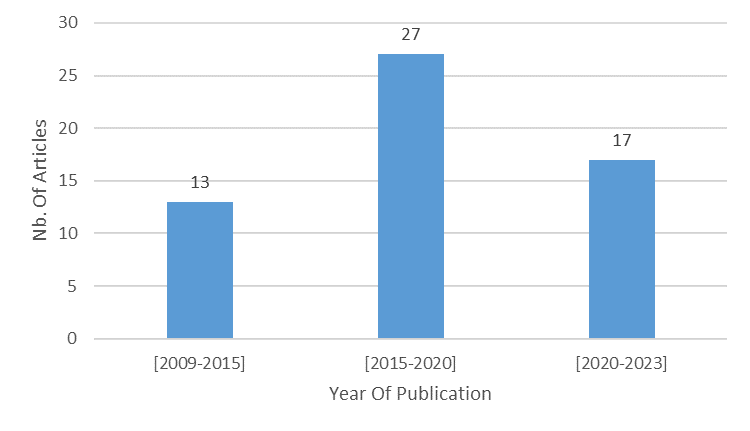
Figure 1. Variation of publications on the use of bacteria in concrete over the years (2009-2023).
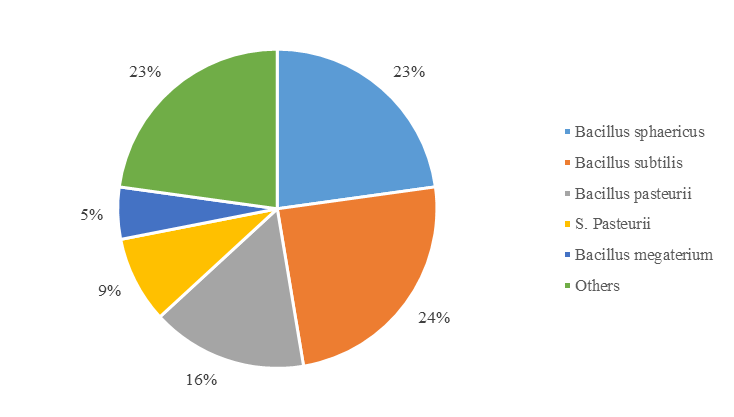
Figure 2. Percentages of different bacteria used in the literature review for concrete applications.
The mechanical behavior of concrete containing different type of bacteria is assessed using the enhancement ratio (ER). The ER indicates the extent of increase or decrease in the strength of the concrete when utilizing various type of bacteria. The ER formula is:
The observed variations in the increase of compressive strength among different bacterial strains during the 7-day curing period provide valuable insights into their effectiveness in enhancing the mechanical properties of concrete. The results depicted in Figure 3 highlight the significant impact of specific bacterial strains, such as B. Sphaericus, B. Subtilis, B. Pasteurii, S. Pasteurii, and B. Mageterium, on the compressive strength improvement.
Sphaericus stands out as the most influential strain, showcasing a remarkable increase in compressive strength ranging from 4.34% to 65.93%. This substantial enhancement positions B. Sphaericus as a promising candidate for concrete applications that require enhanced strength properties (Bashir et al., 2016; C. Durga et al., 2019; Jagadeesha Kumar et al., 2013; Jagannathan et al., 2018; Luhar & Gourav, 2015; Manjunath et al., 2014; Rex et al., 2018; Sahoo et al., 2016; Sonali Sri Durga et al., 2020; Van Tittelboom et al., 2010; Wang et al., 2014). Similarly, B. Subtilis demonstrates a noteworthy increase in compressive strength, ranging from 2.7% to 24.07%. This strain has been extensively studied and exhibits promising outcomes in various research studies (Bashir et al., 2016; C. Durga et al., 2019; C. S. S. Durga & Ruben, 2019; Iswarya et al., 2020; Khaliq & Ehsan, 2016; Luhar & Gourav, 2015; Manikandan & Padmavathi, 2015; Meera & Subha, 2016; Nosouhian et al., 2016; Pachaivannan et al., 2020; Rex et al., 2018; Safiuddin et al., 2022; Seshagiri Rao et al., 2013; Sonali Sri Durga et al., 2020; Venkata Siva Rama Prasad & Vara Lakshmi, 2020).
The impact of B. Pasteurii on compressive strength enhancement falls within the range of 4.34% to 30%, positioning it as a valuable bacterial strain for concrete self-healing and strength improvement (Bashir et al., 2016; C. S. S. Durga & Ruben, 2019; Ganesh Babu & SiddirajuI, 2016; Jagadeesha Kumar et al., 2013; Luhar & Gourav, 2015; Rex et al., 2018; Siddique & Chahal, 2011; Soundharya & Nirmalkumar, 2014). In contrast, S. Pasteurii exhibits a lower effect on the increase of compressive strength, with a range of 1% to 12%. While the enhancement is relatively modest compared to other strains, S. Pasteurii still contributes to the overall improvement (Bhaskar et al., 2017; Chahal et al., 2012; Hosseini Balam et al., 2017; Kishore et al., 2022; Nosouhian et al., 2016). B. Mageterium demonstrates a range of 3% to 20% in compressive strength increase, indicating its potential for reinforcing concrete structures (Andalib et al., 2016; Krishnapriya et al., 2015; Nagarajan et al., 2017).
Figure 4 provides a representation of the increase in compressive strength achieved by B.cohnii (8%-10%), B. halodurans (7%), B. aerius (10.2%), B. flexus (8%), B. Shewanella (35%), and E.coli (52.81%) strains during the 7-day curing period. The range of 7% to 52.81% signifies the diverse effectiveness of these strains in improving the mechanical properties of concrete (Andalib et al., 2016; Hosseini Balam et al., 2017; Jonkers et al., 2010; Kishore et al., 2022; Krishnapriya et al., 2015; Nagarajan et al., 2017; Nguyen et al., 2019; Rex et al., 2018; Seshagiri Rao et al., 2013). These findings underscore the significance of bacterial selection in achieving desired levels of strength enhancement and demonstrate the potential for employing microbial technologies in concrete engineering.
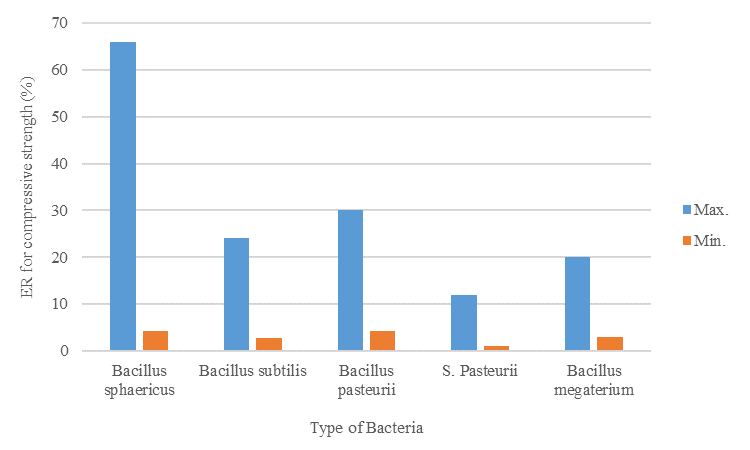
Figure 3. Variation in the compressive strength increase with different bacterial strains during 7-day curing period.
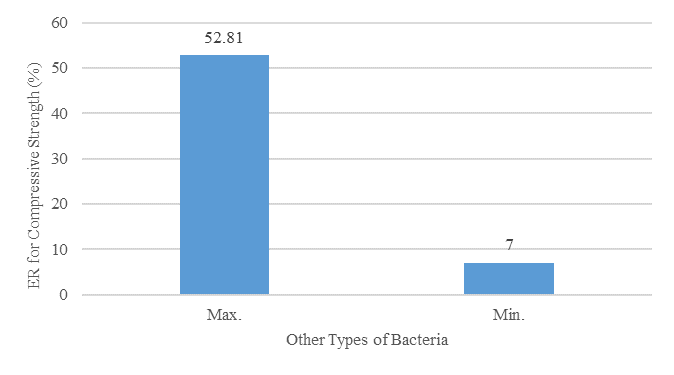
Figure 4. Variation in compressive strength achieved by various bacterial strains during 7-day curing period.
In the analysis of Figure 5, which illustrates the variation in compressive strength increase after a 28-day curing period, the focus was on the performance of different bacterial strains. These strains have been extensively studied and analyzed in numerous publications, making them crucial in the field. Among these strains, B.Sphaericus exhibited the highest maximum increase in compressive strength, ranging from 3.8% to 52.42% (Bashir et al., 2016; C. Durga et al., 2019; Jagadeesha Kumar et al., 2013; Jagannathan et al., 2018; Luhar & Gourav, 2015; Manjunath et al., 2014; Rex et al., 2018; Sahoo et al., 2016; Sonali Sri Durga et al., 2020; Van Tittelboom et al., 2010; Wang et al., 2014). This significant enhancement highlights the effectiveness of B. Sphaericus in enhancing the structural integrity of concrete.
However, it is important to note that the maximum and minimum enhancements for B. Subtilis decreased compared to B. Sphaericus, with an increase ranging from 2.25% to 42.54% (Bashir et al., 2016; C. Durga et al., 2019; C. S. S. Durga & Ruben, 2019; Iswarya et al., 2020; Khaliq & Ehsan, 2016; Luhar & Gourav, 2015; Manikandan & Padmavathi, 2015; Meera & Subha, 2016; Nosouhian et al., 2016; Pachaivannan et al., 2020; Rex et al., 2018; Safiuddin et al., 2022; Seshagiri Rao et al., 2013; Sonali Sri Durga et al., 2020; Venkata Siva Rama Prasad & Vara Lakshmi, 2020). While still demonstrating a positive impact, further investigation may be required to understand the factors influencing the variability of its performance. Similarly, B. Pasteiruu showcased a moderate increase in compressive strength, ranging from 2.63% to 29.97% (Bashir et al., 2016; C. S. S. Durga & Ruben, 2019; Ganesh Babu & SiddirajuI, 2016; Jagadeesha Kumar et al., 2013; Luhar & Gourav, 2015; Rex et al., 2018; Siddique & Chahal, 2011; Soundharya & Nirmalkumar, 2014). These findings suggest that B. Pasteiruu can contribute to the improvement of concrete properties, albeit to a lesser extent than B. Sphaericus.
On the other hand, S. Pasteurii exhibited the least effect on the increase of compressive strength, with a range of 10% to 22% (Bhaskar et al., 2017; Chahal et al., 2012; Hosseini Balam et al., 2017; Kishore et al., 2022; Nosouhian et al., 2016).While its impact may be comparatively lower, it is worth considering other beneficial aspects that S. Pasteurii might offer, such as its ability to contribute to self-healing mechanisms or other desirable properties in concrete.
Additionally, B. Mageterium demonstrated an increase ranging from 5% to 17.51% (Andalib et al., 2016; Krishnapriya et al., 2015; Nagarajan et al., 2017). Although its effect was not as pronounced as B. Sphaericus, B. Mageterium still contributed to the overall improvement of compressive strength in concrete specimens.
Turning our attention to Figure 6, which presents the overall increase in compressive strength achieved by B.cohnii (10%-12%), B. halodurans (18%), B. alkalinitrilicus (7.15%), B. aerius (11.8%), B. flexus (9.72%-10.6%) , B. licheniformis (6.1%), Shewanella (5-40%), and E.coli (62.12%) strains after a 28-day curing period, it is evident that the collective impact of these strains ranged from 6.1% to 62.12% (C. Durga et al., 2019; Ghosh et al., 2009; Jagadeesha Kumar et al., 2013; Krishnapriya et al., 2015; Mohammed et al., 2020; Safiuddin et al., 2022; Siddique et al., 2016; Sierra-Beltran et al., 2014; Sonali Sri Durga et al., 2020).This wide range demonstrates the potential of bacterial interventions in enhancing the mechanical properties of concrete and highlights the need for careful strain selection and optimization.
It is worth mentioning that the reported results may vary depending on factors such as the specific concrete mix design, bacterial concentration, curing conditions, and testing protocols employed in the studies. Further research is necessary to explore these factors and identify the most suitable bacterial strains and conditions for achieving consistent and optimal results in different concrete applications.
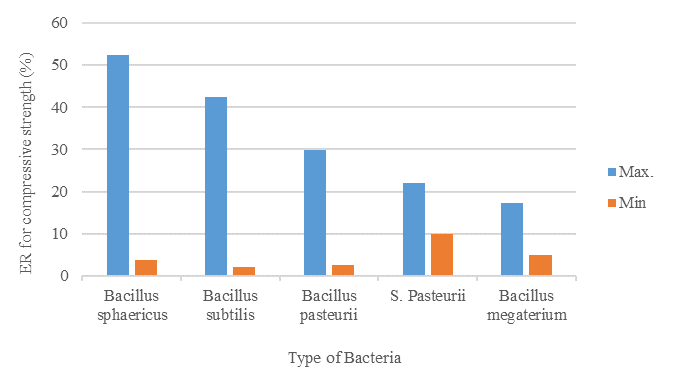
Figure 5. Variation in Compressive Strength Increase with Different Bacterial Strains after 28-Day Curing Period.
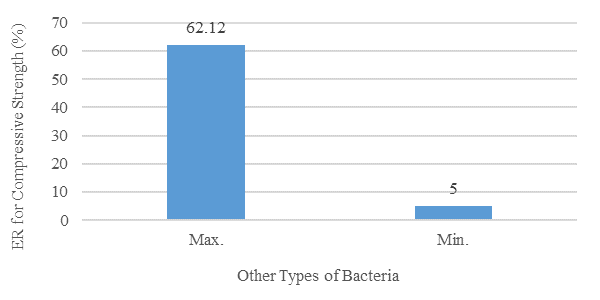
Figure 6. Variation in compressive strength achieved by various bacterial strains during 28-day curing period.
The concentration of bacteria present within the concrete mix has been observed to significantly influence the enhancement of compressive strength. As depicted in Figure 10, the application of five distinct concentrations demonstrates how compressive strength varies in response to each concentration. The investigation commenced with a concentration of 10^3 cells/ml, which corresponded to an Enhancement Ratio (ER) of 10.3%. As the concentration increased, the ER followed suit, peaking at 42.54% for a concentration of 10^5 cells/ml. However, subsequent escalation of the concentration led to a decrease in ER, reaching 23.38% for 10^7 cells/ml. These observations suggest that the optimal concentration for augmenting compressive strength is 10^5 cells/ml (Chahal et al., 2012; C. Durga et al., 2019; Ghosh et al., 2009; Khaudiyal et al., 2022; Manjunath et al., 2014; Meera & Subha, 2016; Nagarajan et al., 2017; Rex et al., 2018). These findings underscore the importance of appropriately calibrating bacterial concentrations to maximize their efficacy in enhancing the compressive strength of concrete.
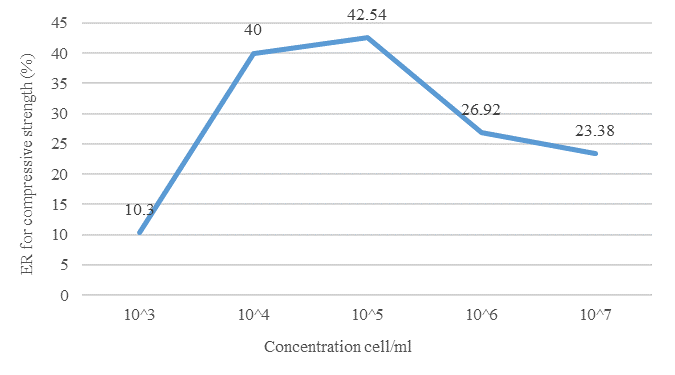
Figure 7. Percentage enhancement of Bacteria concentrations on compressive strength at 28-Days
Observations of variations in the increase of tensile strength among different bacterial strains during a 7-day curing period offer significant insights into their efficacy in augmenting the mechanical properties of concrete. Figure 8 illustrates the profound impact of certain bacterial strains. For instance, B. Sphaericus demonstrated an Enhancement Ratio (ER) ranging from 14.28% to 31.14%, signifying a considerable increase. B. Subtilis exhibited a range from 6.47% to 38.17%, marking it as the bacterial strain with the highest ER effectiveness. Meanwhile, B. Pasteurii showed an average ER of 31.14%, underscoring its vital role in the self-healing process of concrete (Bashir et al., 2016; Jagannathan et al., 2018; Luhar & Gourav, 2015; Meera & Subha, 2016; Nosouhian et al., 2016; Pachaivannan et al., 2020; Rex et al., 2018; Safiuddin et al., 2022; Seshagiri Rao et al., 2013; Sonali Sri Durga et al., 2020).
Further insights into the performance of various bacterial strains are provided in Figure 9, showcasing the variation in the increase of tensile strength after a 28-day curing period. Additional bacterial strains were examined in this figure, illustrating the outcomes at this stage. B. Subtilis recorded the highest increase in tensile strength, with ER ranging from 10% to 63.46%, making it the most promising bacterial strain for enhancing tensile strength. B. Sphaericus followed with an ER range of 2.76% to 28.37%, ranking as the second-highest in terms of ER. B. Megaterium and B. Pasteurii presented average ERs of 15.13% and from 2.76% to 8%, respectively. Conversely, the lowest impact on the increase of tensile strength was attributed to S. Pasteurii, with an ER of 3.44% (Bashir et al., 2016; Jagannathan et al., 2018; Luhar & Gourav, 2015; Meera & Subha, 2016; Nosouhian et al., 2016; Pachaivannan et al., 2020; Rex et al., 2018; Safiuddin et al., 2022; Seshagiri Rao et al., 2013; Sonali Sri Durga et al., 2020). These data indicate the substantial role of bacterial strains in the strength properties of concrete and warrant further research.
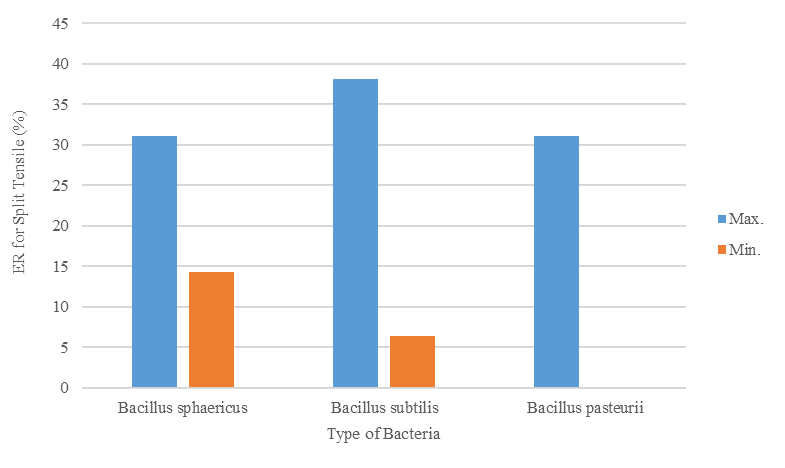
Figure 8. Variation in Split Tensile Increase with Different Bacterial Strains after 7-Day Curing Period.
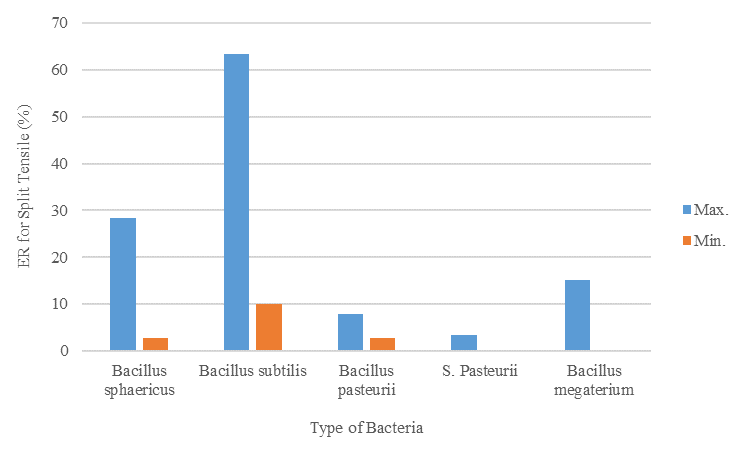
Figure 9. Variation in Split Tensile Increase with Different Bacterial Strains after 28-Day Curing Period.
The flexural strength of concrete exhibited a substantial improvement when various bacterial strains were incorporated. This measurable increase is represented in Figure 10, which portrays the Enhancement Ratio (ER) throughout a 7-day curing process. The ER for B. Sphaericus varied between 2.76% and 29.37%, while for B. Subtilis, it fluctuated from 4.3% to 26.51%. B. Pasteurii, on the other hand, demonstrated a steady enhancement, reflecting an ER of 17.34%. This underscores that the integration of different bacterial strains can significantly augment the flexural strength of concrete (Andalib et al., 2016; Bashir et al., 2016; C. Durga et al., 2019; Jagannathan et al., 2018; Nosouhian et al., 2016; Pachaivannan et al., 2020; Rex et al., 2018; Safiuddin et al., 2022; Seshagiri Rao et al., 2013; Sonali Sri Durga et al., 2020; Venkata Siva Rama Prasad & Vara Lakshmi, 2020).
Figure 11 further delineates the results after a 28-day curing period. Remarkably, the ER percentages for B. Sphaericus and B. Subtilis escalated compared to their day seven results, reaching 31.14% and 30.56%, respectively. These observations suggest the high potential of these bacterial strains for enhancing the flexural strength of concrete.
Contrarily, the ER for B. Pasteurii witnessed a decrease when compared to its value on the seventh day, with figures ranging from 4.69% to 11.18%. The lowest ER was noted for S. pasteurii, contributing an average enhancement of around 6% (Andalib et al., 2016; Bashir et al., 2016; C. Durga et al., 2019; Jagannathan et al., 2018; Nosouhian et al., 2016; Pachaivannan et al., 2020; Rex et al., 2018; Safiuddin et al., 2022; Seshagiri Rao et al., 2013; Sonali Sri Durga et al., 2020; Venkata Siva Rama Prasad & Vara Lakshmi, 2020). These variations emphasize the different impacts of bacterial strains on the flexural strength of concrete over time, marking a valuable area for continued research and analysis.
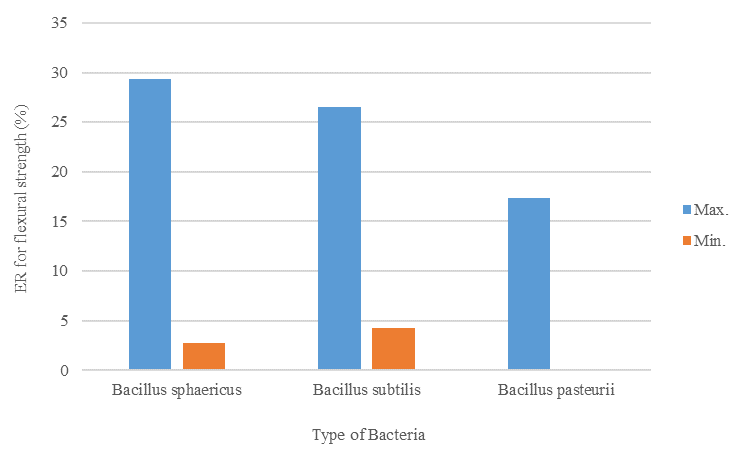
Figure 10. Variation in Flexure Strength Increase with Different Bacterial Strains after 7-Day Curing Period.
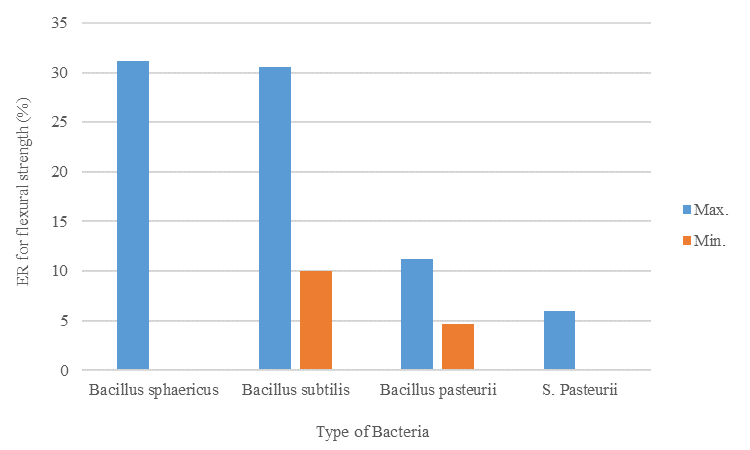
Figure 11. Variation in Flexural Strength Increase with Different Bacterial Strains after 28-Day Curing Period.
Several research studies have highlighted the significant role of different bacterial strains in enhancing the durability of concrete through their impact on its water absorption properties. Firstly, the incorporation of S. Pasteurii bacteria was found to alter the fundamental characteristics of concrete, resulting in a notable decrease in water absorption by 26% (Chahal et al., 2012). This reduction directly correlates with an increase in the durability of the concrete. This finding is further echoed in another study where the impact of S. Pasteurii on the water absorption capability of concrete was investigated (Kishore et al., 2022). The mentioned research results indicated a decline in water absorption by 16.93%.
Moreover, the effect of integration of B. Substilis into the concrete mixture was studied on two different occasions, demonstrating a substantial decrease in water absorption by 81.75% and 16.93% as reported in individual articles (Meera & Subha, 2016; Sonali Sri Durga et al., 2020). This reduction in water absorption, in turn, played a critical role in enhancing the durability of the concrete. Evidently, these various bacterial strains demonstrate significant potential for improving the durability of concrete by minimizing its water absorption, presenting a promising avenue for further exploration in the field of construction materials.
A comparative study between conventional concrete and bacterial concrete was conducted, revealing a notable difference in weight loss after a 28-day curing period. The research showed a weight loss of 2.10% in concrete samples treated with S. Pasteurii bacteria compared to the conventional concrete (Kishore et al., 2022). In a more comprehensive study, three distinct bacterial strains—B. Pasteurii, B. Subtilis, and B. Sphaericus—were incorporated into the concrete mix, and both weight and strength loss in the concrete samples were observed. The study’s findings indicated weight loss figures ranging from 27.42% to 46.34%, while strength loss ranged between 7.31% and 17.47% (Rex et al., 2018).
In the same comprehensive research, significant insights into the influence of three specified bacterial strains on concrete durability were provided. The results revealed varying impacts based on the bacterial strain involved. Specifically, B. Pasteurii, B. Subtilis, and B. Sphaericus were found to cause durability losses of 5.84%, 6.65%, and 2.45%, respectively. These findings highlight the nuanced role that each bacterial strain plays in shaping the overall durability of bacterial concrete (Rex et al., 2018).
After a comprehensive examination of the effects of alkaline attack on concrete mixed with three different bacterial strains, focusing on the resulting changes in weight and compressive strength, distinct outcomes were observed based on the bacterial strain used. Specifically, when considering weight loss, B. Pasteurii resulted in a reduction of 33%, B. Subtilis accounted for a decrease of 24.24%, and B. Sphaericus led to a weight loss of 17.81%.
Similarly, in terms of compressive strength loss, varying patterns were observed depending on the type of bacteria incorporated. B. Pasteurii, B. Subtilis, and B. Sphaericus contributed to compressive strength losses of 2.31%, 5.47%, and 17.81%, respectively. These findings highlight the diverse impacts that different bacterial strains can have on the resistance of concrete to alkaline attack, ultimately affecting its durability and long-term performance (Rex et al., 2018).
Waste materials such as silica fume, GGBFS, and fly ash are used in bacterial concrete mixtures. These waste materials have an impact on the mechanical properties of bio-concrete.
An article titled “Experimental Investigation of Self-Healing Behavior of Concrete Using Silica Fume and GGBFS as Mineral Admixtures” conducted a study. In this study, cubes were formed by blending cement with various percentages of silica fume as a binder, including 2.5%, 5%, 7.5%, 10%, and 12.5%. Additionally, cubes were created by replacing 35% to 55% of the cement with GGBFS. A standard mixture without admixtures was cast to facilitate comparison of the strength and durability of the concrete with those prepared using silica fume and GGBFS. Compressive strength tests were performed on preloaded concrete specimens after 7 and 28 days, with the Sorptivity index determined after 28 days. Notably, the concrete mix containing 35% GGBFS instead of cement exhibited the highest compressive strength rating. Furthermore, the optimal strength was achieved when a mineral admixture consisting of 12.5% silica fume was added to the combination (Depaa & Felix Kala, 2015).
Another study focused on evaluating the effect of Sporoscarcina pasteurii bacteria on the compressive strength and rapid chloride permeability of concrete, both with and without fly ash. Cement was replaced by fly ash in three percentages: 10%, 20%, and 30%. The concrete mixes contained varying cell concentrations of bacteria (0, 10^3, 10^5, and 10^7 cells/ml). At 28 days, tests were conducted to measure compressive strength, water absorption, and rapid chloride permeability. The presence of S. Pasteurii in fly ash concrete increased compressive strength while decreasing porosity and permeability, as indicated by test results. With a bacteria concentration of 10^5 cells/ml, the compressive strength increased by 22% and water absorption reduced significantly (Chahal et al., 2012).
Another endeavor aimed to comprehend the combined effect of bacteria and fly ash on the performance of M20 grade concrete. While maintaining a constant concentration of Sporosarcina pasteurii bacteria at 10^6 cells/ml, fly ash content was altered by 0%, 10%, 20%, and 30% as a replacement for cement. Cubes and cylinders were cast, and their strength was measured after 7, 28, 56, and 90 days. The results indicated that a mixture of 10^6 cells/ml bacteria and 20% fly ash yielded optimal outcomes in terms of compressive strength, split tensile strength, strength loss, weight loss, and water absorption (Kishore et al., 2022).
Furthermore, an experimental study’s results were presented in a paper, assessing the influence of Bacillus sphaericus bacteria on the compressive strength, split tensile strength, flexural strength, shear strength, water absorption, and chloride permeability of concrete made with and without fly ash. Cement was replaced by fly ash in two percentages: 10% and 20%. The concrete mixtures included different cell concentrations of bacteria (0, 10^3, 10^5, and 10^7 cells/ml). Testing was conducted at 28 days. The incorporation of B. sphaericus in fly ash concrete increased compressive strength while reducing water absorption and chloride permeability. With a bacteria concentration of 10^5 cells/ml, the maximum increase in compressive strength reached 15.47%. This study focuses on the impact of bacteria on concrete characteristics, particularly when using supplementary cementing materials such as fly ash. The utilization of bacteria such as B. sphaericus enhances the strength and durability of fly ash concrete through self-healing mechanisms (Manjunath et al., 2014).
In this literature review, the principles of bio-concrete, which involves the incorporation of bacteria or microorganisms to facilitate crack healing, were thoroughly discussed. Additionally, various types of bacteria and their corresponding growth conditions were examined. The review also extensively covered the enhancement on mechanical properties of concrete using different types of bacteria.
In conclusion, it is reasonable to assert that the concept of bio-concrete offers a promising solution to address concrete degradation and maintenance challenges in rehabilitation. The incorporation of bacteria or microorganisms in bio-concrete has compellingly demonstrated the ability to facilitate crack healing.
During the review process, a prominent limitation became evident: there was a scarcity of publications that comprehensively covered the topic of bacterial concrete. Furthermore, when exploring available publications, only a few discussed cases involving the healing of pre-cracked beam or structures using bacteria. Additionally, details about the depth and range of cracks that can be effectively healed by bacteria were lacking in most of the publications. Moreover, information about the various types of cracks that commonly occur in buildings was not disclosed. Additionally, data pertaining to the mechanical properties at the 14 and 21 day marks were insufficiently available. Furthermore, challenges such as the long-term viability and activity of bacteria, as well as the scalability and economic feasibility of large-scale production and implementation, remain unaddressed. In an era where numerous old buildings require repairs or redesigning to combat cracks, this topic emerges as a vital subject warranting further research. Such research has the potential to introduce innovative approaches that contribute to the enhancement of infrastructural integrity.
Cite: Zeaiter, H., Jahami, A., & Khatib, J. (2023). Bio-Concrete and Beyond: Advancements in Self-Healing Techniques for Durable Infrastructure. Steps For Civil, Constructions and Environmental Engineering, 1(1), 18–29. https://doi.org/10.61706/sccee120112
Copyright: © 2023 by the authors. Licensee SSG, Dubai, UAE.
This article is an open access article distributed under the terms and conditions of the Creative Commons Attribution (CC BY-NC-ND 4.0) license (http://creativecommons.org/licenses/by-nc-nd/4.0/).






An independent academic publisher with an editorial team including many of the top researchers in the world. SSG publishes research, review, and case report articles in double-blind, peer-reviewed, open access scientific and academic journals.
Copyright © 2023 Scientific Steps International Publishing Services LLC (Dubai – United Arab Emirates)